University update on student recommendations on diversity
by Cara Neth | December 19, 2016 4:12 PM
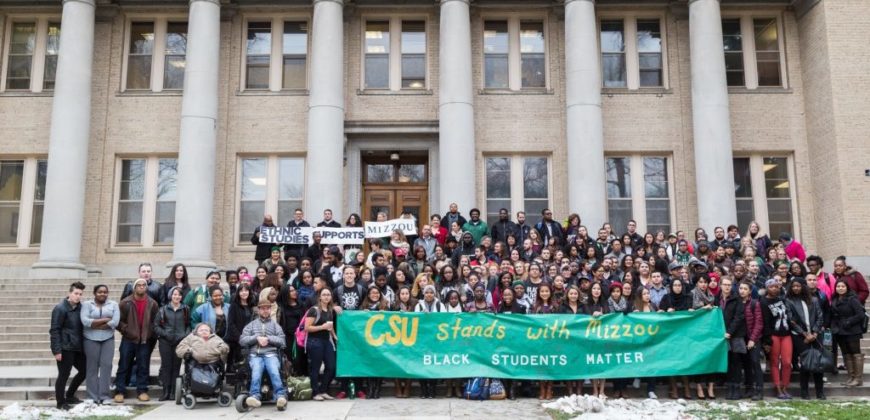
CSU students, staff and faculty rallied on the steps of the Administration Building on Nov. 16, 2015, and delivered a list of recommendations on how to improve support of diverse populations to President Tony Frank. Collegian photo by Ryan Arb.
On Nov. 16, 2015, Colorado State students, staff, and faculty rallied in support of their peers at the University of Missouri who were speaking out against racially motivated violence and discrimination. CSU President Tony Frank joined the march that day, and left with a list of recommendations from the students about how Colorado State could improve its own support of diverse populations.
In the year since, Frank’s leadership team has been focused on responding to the ideas brought forward that day – recommendations related to institutional planning, hiring, curriculum, athletics, student support, and governance.
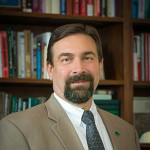
“The students pointed out some areas for improvement that made good sense for the University and that are very much in line with our commitment to do better in supporting and advocating for diversity and inclusion at CSU,” Frank said. “This isn’t new for us – it’s a challenge we’ve embraced and worked on for a long, long time. But the energy and experiences of our students can help us view any challenge in a new and more innovative way, and that’s what happened here. These recommendations have been a touchstone for us this past year as we’ve looked closely at what we should be doing as an institution – and how to actually get it done.”
Vice President for Diversity Mary Ontiveros concurred. “When we first met to talk about the recommendations and what we might do, we all agreed these ideas could have an important and transformative impact on continuing to improve the climate for racial and ethnic diversity on campus. These aren’t changes that will happen overnight – some will take years. But there has been strong support for moving forward, and we’ve gotten the ball rolling in some key areas.”
Below is a summary of the recommendations and how the University has responded to date. In the spring, President Frank will review the full report with the President’s Multicultural Student Advisory Committee (PMSAC) and ASCSU.
Recommendation: “We recommend that the University create a strategic five-year plan for increasing diverse populations and meeting the other recommendations with a select board of diverse students and faculty to vet, maintain, and oversee the process.”
University Update: A working group of CSU administrators, faculty and staff organized to address diversity issues across campus had been meeting for several months prior to the students’ rally. In response to the students’ recommendation that the University create a “select board to oversee the process of implementing a strategic plan,” this group was restructured to include a representative from every college; representatives from each campus division (Student Affairs, External Relations, Engagement, Enrollment and Access, Advancement and Operations); and representatives from employee councils (Administrative Professional Council, Classified Personnel Council, and Faculty Council). Additionally, as per the recommendation, this group expanded to include students, with representatives from ASCSU, Graduate Council, and the President’s Multicultural Student Advisory Committee (PMSAC).
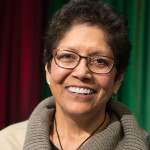
In the spring of 2016, this group became the President’s Commission for Diversity and Inclusion (CDI) with the goal of meeting and exceeding the students’ recommendation for a “select board” to oversee the development and implementation of a strategic diversity plan. Paramount to these efforts will be establishing structures that promote accountability for the creation and implementation of environments where diversity, inclusion, and equity are valued. The CDI will be focused on accountability and will provide input regarding the status of diversity efforts in all members’ respective areas.
Currently the CDI is creating a campus-wide strategic diversity plan. In addition, the CDI has committees working on issues including hiring and campus climate.
Recommendation: “We recommend that the university significantly increase the percentage of racially diverse faculty and staff.”
University Update: Colorado State agreed to make the EAB (Educational Advisory Board) national “best practices” report its hiring and recruitment template. This report outlines effective strategies for increasing faculty diversity based on extensive national data, with specific information on universities that have achieved faculty diversity rates that outpace their peers. Areas of focus for CSU going forward may include better incentivizing academic departments, more aggressive hiring from the national pool of Ph.D.s, a “grow your own” approach, and more. The University will also explore developing funding for areas of research that align with the work of many diverse faculty members. The new Commission for Diversity and Inclusion is also working on recommendations related to hiring and recruitment.
Recommendation: “We recommend increased funding and resources for the Student Diversity Programs and Services (SDPS) offices and increased funding resources for mental health issues specifically dealing with racial oppression and racial battle fatigue.”
University Update: In the first year of a multi-year funding request, the University approved funds to increase
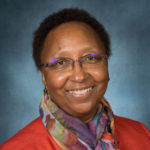
programming dollars, provide equity increases for SDPS staff, and re-establish positions to more fully staff each office. Additionally, this summer, the Counseling Center hired a psychologist whose specialty is working with racial battle fatigue for students of color on predominantly white campuses. This position works closely with the SDPS offices.
“This has been a great step, but we still have a lot of work to do,” Vice President for Student Affairs Blanche Hughes said. “Our plan over the next few years is to continue to increase staff and programming where needed to meet the needs of students and the university.”
Recommendation: “We recommend a campus-wide curriculum change to require Introduction to Ethnic Studies and Introduction to Women Studies to be taken by all students. Additionally, we recommend the inclusion of Women Studies courses in the Global and Cultural Awareness category of the AUCC, as it currently is not included.”
University Update: Faculty Council, working with the Vice Provost for Undergraduate Affairs, has taken the lead on
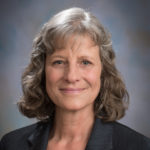
considering possible short- and long-term curriculum changes. This past spring, the University Curriculum Committee (UCC) met to discuss how to meet this recommendation in a way that could provide more than just the introduction of a new course or courses in the All University Core Curriculum (AUCC), but would instead provide a curriculum that would be sustainable over time.
To begin the process, the UCC began an inventory of the entire course catalog to come up with a set of existing courses that might already address diversity and inclusion in the way intended. As those courses emerge, the UCC will reach out to faculty members for further descriptions and encourage them to put the courses through the AUCC requirement process.
The committee also reviewed the AUCC category 3E and considered the courses that meet cultural awareness versus globalization/international studies. Currently, the 3E category offers courses in Social Work, Ethnic Studies, and Speech Communication that fulfill the criteria for diversity and cultural awareness. The UCC and Vice Provost Kelly Long have reached out to departments to encourage submission of new courses to the 3E category.
At the President’s Fall Leadership Forum in September – which involves all academic deans and department chairs – how to increase diversity in the curriculum was one of the primary topic areas.
“While we’ve made some short-term progress, we will continue to work on a long-term solution that focuses on integrating learning objectives related to diversity and inclusion throughout the curriculum,” Faculty Council Chair Mary Stromberger said.
Recommendation: “We recommend the creation of diversity representative positions in the student government (ASCSU) senate and on the Faculty Council.”
University Update: ASCSU in spring 2016 passed a bill allocating nine senator seats and nine associate senator seats to
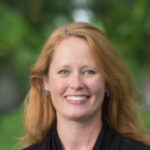
representatives for the SDPS offices, International Programs and Services, and the Adult Learner and Veterans Services Office. The bill also leaves the door open for other student organizations representing historically underrepresented group to petition for a seat in the student senate – and this fall, a seat was created through this mechanism to represent diverse religious organizations.
There is still work to be done on policy and clarification of the definition of “underrepresented” groups – and on increasing diversity on the college councils, which would influence the overall diversity of ASCSU senate representation.
Stromberger noted that Faculty Council membership turns over regularly, and with the many committees that do work on behalf of the Council, there is typically a good representation of diversity in faculty governance.
Recommendation: “We recommend the increased focus on resolving the problems facing graduation rates for athletes of color and lack of post-graduate opportunities.”
University Update: President Frank charged Ram Athletics to look at national best practices and relevant data to inform

targets that will help CSU become a national leader in this area. Athletic Director Joe Parker is taking the lead on prioritizing culture and diversity within the Athletics department and engaging more coaches in the process. With the leadership of Dr. Albert Bimper, the department reconvened the Athletics Diversity Council as a working group to improve the University’s assessment of student-athletes’ readiness and identify key areas of investment to improve student learning. This council has met several times to look at graduation rates and begin compiling the data to assess what problems may exist and what strategies can be put in place to move forward.
The data so far is encouraging, indicating the University has virtually eliminated gaps in graduation rates for student-athletes. In the last three years, freshmen football players have earned an equal or better GPA than the average freshman, and all freshmen football players are now part of the Key Communities, increasing their support network and connections with the broader student community. The University continues to focus on addressing gaps where they are identified – noting that student-athletes who start and finish their degrees at CSU have tended to have greater levels of success and engagement than those who transfer into CSU.

The Athletics Department recently introduced a number of new efforts to strengthen learning opportunities for student-athletes, including expanded internship and service-learning options, a summer school program, the addition of a learning specialist on staff, and closer collaboration with TILT (Institute for Learning and Teaching). The department this fall sponsored a Courageous Conversation Conference, facilitated by the Center for Public Deliberation, to help empower student athletes to be able to have difficult conversations when issues come up. The conference, part of a national conversation addressing issues around police and the Black community – as well as broader questions of race and identity – included a panel of coaches, student athletes, police officers, and psychologists.
“These are important issues for college athletics programs nationally, not just at CSU, but we feel good about the direction we’re headed,” Parker said. “We’re committed, and we’ve made it a priority.”
Source URL: https://source.colostate.edu/university-update-student-recommendations-diversity/
Copyright ©2024 SOURCE unless otherwise noted.